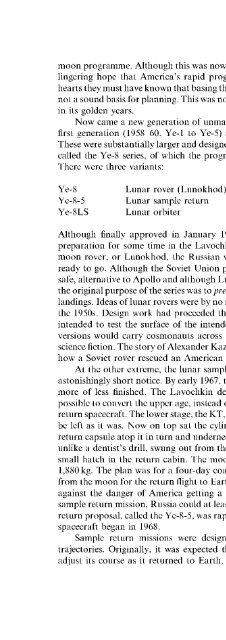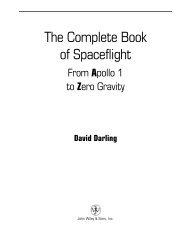Soviet and Russian Lunar Exploration
Soviet and Russian Lunar Exploration
Soviet and Russian Lunar Exploration
You also want an ePaper? Increase the reach of your titles
YUMPU automatically turns print PDFs into web optimized ePapers that Google loves.
moon programme. Although this was nowhere written down, there was probably the<br />
lingering hope that America's rapid progress might hit some delays. But, in their<br />
hearts they must have known that basing their progress on the difficulties of others was<br />
not a sound basis for planning. This was not how the <strong>Soviet</strong> space programme worked<br />
in its golden years.<br />
Now came a new generation of unmanned <strong>Russian</strong> moon probes, following the<br />
first generation (1958-60, Ye-1 to Ye-5) <strong>and</strong> the second (1963-8, Ye-6 <strong>and</strong> Ye-7).<br />
These were substantially larger <strong>and</strong> designed to be launched on the Proton rocket <strong>and</strong><br />
called the Ye-8 series, of which the programme chief designer was Oleg Ivanovski.<br />
There were three variants:<br />
Ye-8 <strong>Lunar</strong> rover (Lunokhod) (originally the L-2 programme)<br />
Ye-8-5 <strong>Lunar</strong> sample return<br />
Ye-8LS <strong>Lunar</strong> orbiter<br />
Although finally approved in January 1969, these missions had actually been in<br />
preparation for some time in the Lavochkin design bureau. Available first was the<br />
moon rover, or Lunokhod, the <strong>Russian</strong> word for 'moonwalker', <strong>and</strong> it was nearly<br />
ready to go. Although the <strong>Soviet</strong> Union portrayed the Lunokhod series as a cheap,<br />
safe, alternative to Apollo <strong>and</strong> although Lunokhods followed the American l<strong>and</strong>ings,<br />
the original purpose of the series was to precede <strong>and</strong> pave the way for <strong>Russian</strong> manned<br />
l<strong>and</strong>ings. Ideas of lunar rovers were by no means new <strong>and</strong> dated, as noticed earlier, to<br />
the 1950s. Design work had proceeded throughout the 1960s. The moon rover was<br />
intended to test the surface of the intended site for the first manned l<strong>and</strong>ing; later<br />
versions would carry cosmonauts across the moon. Indeed, they were endorsed in<br />
science fiction. The story of Alex<strong>and</strong>er Kazanstev's Lunnaya doroga (<strong>Lunar</strong> road) was<br />
how a <strong>Soviet</strong> rover rescued an American in peril on the moon [1].<br />
At the other extreme, the lunar sample return mission had been put together at<br />
astonishingly short notice. By early 1967, the design of the Ye-8 lunar rover had been<br />
more of less finished. The Lavochkin design bureau figured out that it might be<br />
possible to convert the upper age, instead of carrying a lunar rover, to carry a sample<br />
return spacecraft. The lower stage, the KT, required almost no modification <strong>and</strong> could<br />
be left as it was. Now on top sat the cylindrical instrumentation unit, the spherical<br />
return capsule atop it in turn <strong>and</strong> underneath an ascent stage. A long robot arm, not<br />
unlike a dentist's drill, swung out from the descent stage <strong>and</strong> swivelled round into a<br />
small hatch in the return cabin. The moonscooper's height was 3.96 m, the weight<br />
1,880 kg. The plan was for a four-day coast to the moon, the upper stage lifting off<br />
from the moon for the return flight to Earth. The mission was proposed as insurance<br />
against the danger of America getting a man on the moon first. At least with the<br />
sample return mission, Russia could at least get moon samples back first. The sample<br />
return proposal, called the Ye-8-5, was rapidly approved <strong>and</strong> construction of the first<br />
spacecraft began in 1968.<br />
Sample return missions were designed to have the simplest possible return<br />
trajectories. Originally, it was expected that a returning spacecraft would have to<br />
adjust its course as it returned to Earth. In the Institute of Applied Mathematics,







